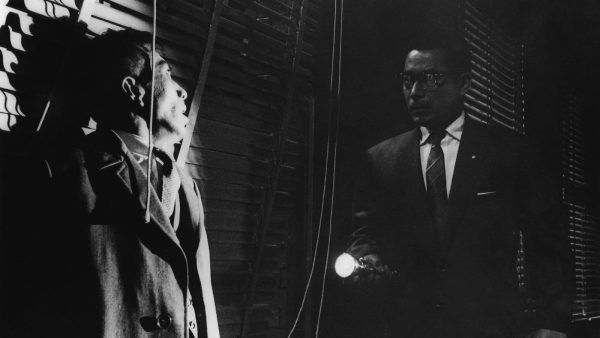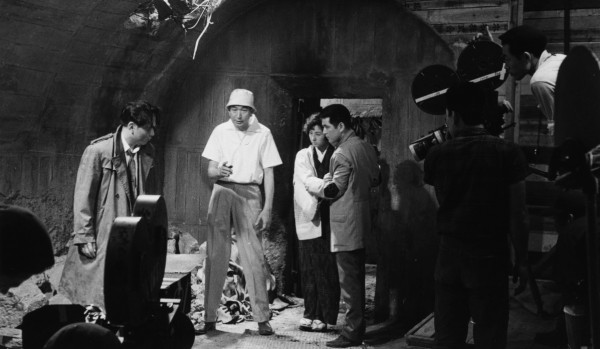
Nishi (Toshirô Mifune) is desperate for revenge in Akira Kurosawa’s dark Shakespearean noir, THE BAD SLEEP WELL
WEEKEND CLASSICS: THE BAD SLEEP WELL (悪い奴ほどよく眠る) (Akira Kurosawa, 1960)
IFC Center
323 Sixth Ave. at West Third St.
December 23-27, 11:00 am
212-924-7771
www.ifccenter.com
 IFC Center’s eleven-film Weekend Classics series “Kurosawa & Mifune” comes to a close Christmas weekend with one of the pair’s underseen best, the Shakespearean noir, The Bad Sleep Well. The twelfth of sixteen films director Akira Kurosawa and actor Toshirô Mifune made together between 1948 and 1965, The Bad Sleep Well is a tense, gripping thriller in which Kurosawa takes on post-WWII Japanese corporate culture, incorporating elements of Hamlet into the complex narrative. The 1960 film begins with a long wedding scene in which everything is set in motion, from identifying characters (and their flaws) to developing the central storylines. Kōichi Nishi (Mifune) is marrying Yoshiko (Kyōko Kagawa), a young woman with a physical disability whose father is Iwabuchi (Masayuki Mori), the vice president of Public Corporation, a construction company immersed in financial scandal as related by one of the many cynical reporters (Kōji Mitsui) covering the party and anticipating possible arrests. Also at the affair are Iwabuchi’s cohorts in crime, Miura (Gen Shimizu), Moriyama (Takashi Shimura), Shirai (Kō Nishimura), and Wada (Kamatari Fujiwara), as well as Iwabuchi’s rogue son, Tatsuo (Tatsuya Mihashi), who threatens to kill Nishi if he does anything to hurt his sister. It soon becomes clear that Nishi in fact does have more on his mind than just marrying into the company. “Even now they sleep soundly, grins on their faces,” Nishi declares. “I won’t stand for it! I can never hate them enough!”
IFC Center’s eleven-film Weekend Classics series “Kurosawa & Mifune” comes to a close Christmas weekend with one of the pair’s underseen best, the Shakespearean noir, The Bad Sleep Well. The twelfth of sixteen films director Akira Kurosawa and actor Toshirô Mifune made together between 1948 and 1965, The Bad Sleep Well is a tense, gripping thriller in which Kurosawa takes on post-WWII Japanese corporate culture, incorporating elements of Hamlet into the complex narrative. The 1960 film begins with a long wedding scene in which everything is set in motion, from identifying characters (and their flaws) to developing the central storylines. Kōichi Nishi (Mifune) is marrying Yoshiko (Kyōko Kagawa), a young woman with a physical disability whose father is Iwabuchi (Masayuki Mori), the vice president of Public Corporation, a construction company immersed in financial scandal as related by one of the many cynical reporters (Kōji Mitsui) covering the party and anticipating possible arrests. Also at the affair are Iwabuchi’s cohorts in crime, Miura (Gen Shimizu), Moriyama (Takashi Shimura), Shirai (Kō Nishimura), and Wada (Kamatari Fujiwara), as well as Iwabuchi’s rogue son, Tatsuo (Tatsuya Mihashi), who threatens to kill Nishi if he does anything to hurt his sister. It soon becomes clear that Nishi in fact does have more on his mind than just marrying into the company. “Even now they sleep soundly, grins on their faces,” Nishi declares. “I won’t stand for it! I can never hate them enough!”

Akira Kurosawa on set at the abandoned munitions factory in THE BAD SLEEP WELL
Photographed in an enveloping, almost 3-D black-and-white by Yuzuru Aizawa and with a propulsive, jazzy score by Masaru Sato, The Bad Sleep Well is a deeply psychological, eerie tale that finds inspiration in the story of Hamlet, Polonius, Ophelia, Claudius, Gertrude, Laertes, and Horatio. But whereas Kurosawa’s Throne of Blood and Ran were more direct interpretations of Macbeth and King Lear, respectively, Kurosawa, who edited the film and cowrote it with Hideo Oguni, Eijirô Hisaita, Ryûzô Kikushima, and Shinobu Hashimoto, uses the Shakespeare tragedy more subtly as he investigates greed, envy, revenge, betrayal, suicide, torture, ghosts, and murder; in fact, many critical plot points, including those involving violence, occur offscreen. The locations are spectacular, especially a volcano and an abandoned, decimated munitions factory that clearly references the destruction wrought by WWII. The actors wear their hearts on their sleeves, often emoting with silent-film tropes, especially Shimura, Fujiwara, and Nishimura as Iwabuchi’s nervous, perpetually worried underlings and Mihashi as the wild, unpredictable prodigal son. Mifune is stalwart throughout, wearing pristine suits and eyeglasses that mask what is bubbling inside him, threatening to explode, while Mori is a magnificently evil villain. At 150 minutes, it’s a long film, but it’s worth every minute; it could have actually been longer, but Kurosawa, in his first film made through his own independent production company, instead chose an abrupt yet fascinating ending with all kinds of future implications. Made between the period piece The Hidden Fortress and the samurai Western Yojimbo, The Bad Sleep Well was advertised as “a film that will violently jolt the paralyzed soul of modern man back to its senses,” and it still does just that, as corporate corruption seems to never end. Oh, and it also features one of the best wedding cakes ever put on celluloid.